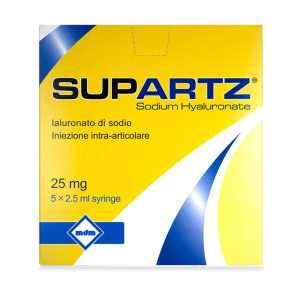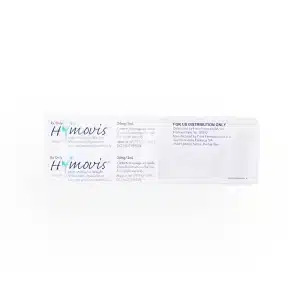Osteoarthritis (OA) affects over 54 million adults in the United States, with the knee being one of the most commonly affected joints. Viscosupplementation has emerged as a valuable treatment to restore natural lubrication and shock absorption within the knee, offering relief for many OA patients.
Among the available options, Supartz and Synvisc are two popular viscosupplements, both based on hyaluronic acid but differing in formulation and treatment protocols. Understanding these differences can help patients and healthcare providers make an informed choice for effective, personalized knee OA care.
In this article, we’ll compare Supartz vs Synvisc to help you decide which option might be best for treating knee osteoarthritis.
Key Takeaways
- Supartz and Synvisc are hyaluronic acid-based viscosupplement injections that aim to alleviate knee osteoarthritis pain by improving and restoring joint lubrication.
- Supartz requires a series of 3 to 5 injections, while Synvisc typically involves 1 to 3 injections.
- Supartz is often more affordable than Synvisc, though insurance coverage for both treatments varies.
- Clinical studies show that both Supartz and Synvisc effectively reduce pain and enhance joint function, with high patient satisfaction reported for each.
- Individual preferences, such as cost, convenience, and speed of results, help guide the choice between the two.
About: Medical Spa RX provides medical practices with premium products at the best prices. If you’re looking to buy Supartz for your practice, the sales representatives at Medical Spa RX can give you guidance.
Understanding Supartz and Synvisc
Supartz and Synvisc are hyaluronic acid-based viscosupplements commonly used to relieve knee pain caused by osteoarthritis. Designed to restore the natural lubricating fluid in the knee joint, these treatments can improve mobility and reduce pain when other options have proven ineffective.

Known for its affordability, Supartz is often a preferred choice for patients seeking effective relief at a lower cost. Its multi-injection approach allows for gradual improvement over several sessions.
With Synvisc, it usually requires fewer injections, offering added convenience for patients who prefer fewer doctor visits. Due to its unique formulation, Synvisc may provide quicker relief for some patients.
Active Ingredients and Mechanism of Action
Supartz is formulated with a straightforward hyaluronic acid solution that enhances joint fluid, promoting smoother movement and delaying the need for more invasive treatments. Its gradual approach offers patients steady relief over the course of treatment.

While Synvisc contains hyaluronic acid, it uses a unique formulation that delivers rapid absorption and efficiency. Its distinctive structure may provide faster pain relief and smoother joint motion, especially appealing to patients looking for quicker improvement with fewer sessions.
Administration Methods and Treatment Regimens
Supartz and Synvisc are both administered directly into the knee joint via intra-articular injections performed by a healthcare professional. These injections are typically completed in a clinical setting to ensure precision and safety.

Supartz is typically administered once a week for a total of 3 to 5 injections, while Synvisc is usually given once a week for 3 injections. Both treatments require strict adherence to aseptic techniques to avoid infection.
When comparing the treatment regimens, Supartz may offer a longer treatment duration with up to 5 injections, potentially providing extended relief. On the other hand, Synvisc is known for its higher molecular weight, which might offer superior viscoelastic properties and longer-lasting effects with fewer injections.
Clinical Efficacy and Patient Satisfaction
Clinical trials have shown that Supartz effectively reduces pain and improves joint function by restoring lubrication and cushioning in the joint. Adding to this, patients who receive this treatment typically experience significant relief with minimal side effects.
- Suz…: “I had five injections into one of my knees and started seeing near immediate baby step results, and by the fifth injection, my knee was extremely happy. I would give it a good 95% at this very early stage. Ready to start my other knee.“
Meanwhile, studies on Synvisc indicate that it can provide long-lasting pain relief and enhanced joint mobility. Patients also have positive experiences with this viscosupplement, with some praising its ability to delay knee surgery totally.
- Nei..: “I have used Synvisc for 7 years (getting injections every 6 months) and my doctor said I could be the poster child for the treatment. It held off my knee replacement by at least 5 years. I’d recommend it to anyone.”
Practical Implications and Considerations
When choosing between Supartz vs Synvisc, cost and insurance coverage are key factors for many patients. Supartz tends to be more affordable than Synvisc, making it a popular choice for those looking to manage knee osteoarthritis without high out-of-pocket expenses. However, treatment costs can vary significantly depending on location, provider, and the patient’s specific needs.
Insurance coverage often plays a significant role in the decision-making process. Both Supartz and Synvisc are typically covered by insurance for osteoarthritis treatment, but coverage details vary by provider and policy. Patients should confirm with their insurance company to understand their options fully.
Practical Considerations for Choosing Between Supartz and Synvisc
Supartz requires multiple injections over a few weeks, while Synvisc often involves fewer injections, which can be more convenient for patients looking to minimize clinic visits.
For those comparing viscosupplements, such as Supartz vs Euflexxa, similar factors—like cost, coverage, and treatment regimen—can help determine the most suitable choice for effective relief. Discussing these options with a healthcare provider can also be helpful.
Conclusion
Choosing between Supartz and Synvisc depends on each patient’s unique needs and priorities. Supartz may be more budget-friendly and provides gradual relief through a multi-injection approach, while Synvisc offers the convenience of fewer injections and potentially faster results.
Both treatments effectively manage knee osteoarthritis pain, so the best choice will depend on individual preferences, budget considerations, and specific treatment goals.
FAQs
1. What are the main differences between Supartz and Synvisc?
Supartz generally requires more injections (3 to 5), while Synvisc often requires fewer (1 to 3). Supartz tends to be more cost-effective, whereas Synvisc offers the convenience of fewer appointments and may provide faster relief for some patients.
2. How long do the effects of Supartz and Synvisc last?
The effects of both treatments can last for several months, with some patients experiencing relief for up to six months or more. However, individual results vary based on factors like knee condition and lifestyle.
3. Are Supartz and Synvisc covered by insurance?
Many insurance providers cover viscosupplement treatments for osteoarthritis, though coverage can vary. It’s best to consult your provider to confirm specific coverage details for either treatment.
4. Are there side effects associated with Supartz or Synvisc?
Common side effects include mild swelling, pain, or bruising at the injection site, which typically resolve within a few days.
References
National Center for Health Statistics. National Health Interview Survey Data, 2021–2023. https://www.cdc.gov/nchs/nhis/data-questionnaires-documentation.htm
Peck J, Slovek A, Miro P, et al. A Comprehensive Review of Viscosupplementation in Osteoarthritis of the Knee. Orthopedic Reviews. Published online July 10, 2021. doi:https://doi.org/10.52965/001c.25549
Supartz FX. RxList. Published June 14, 2022. https://www.rxlist.com/supartz-fx-drug.htm





















